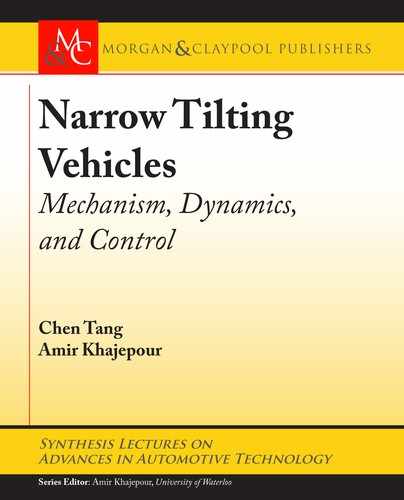32 4. TILTING VEHICLE CONTROL
4.2.2 ACTIVE ROLL CONTROL FOR NARROW TILTING VEHICLES
For NTVs, which are more like motorcycles than conventional cars, an active rollover mitigation
is even more crucial. Compared with two-wheelers, the increased system weight along with the
enclosed cabin of NTVs makes the balancing control much more difficult to be executed by
human drivers. Such vehicles are also expected to be operated by drivers without sufficient skill
and experience to lean the vehicle when cornering. Consequently, active tilting control systems
have been developed to keep vehicles in balance without the driver’s direct intervention. ere are
mainly three different types of tilting control schemes for NTVs known as Direct Tilt Control
(DTC), Steering Tilt Control (STC), and a combination of Steering and Direct Tilt Control
(SDTC).
Direct Tilting Control (DTC)
For DTC systems, tilting actuators rotate the body relative to the chassis, and the steering sys-
tem is used exclusively for lateral control [7]. e desired tilting angle is first determined by
considering the vehicle speed, the road curvature and vehicle running states. e controller then
tracks the desired angle using tilting actuators. Strategies to determine an appropriate tilting
angle are crucial to DTC system designs.
e common method to calculate the desired tilting angle is based on the idea of balancing
the centrifugal force during steady-state cornering [7] like motorcycles. e idea is adopted in [2,
60, 61] for DTC system designs. A more complicated version is suggested in [7], which takes
the vehicle lateral acceleration and gyroscopic moments of rotating wheels into considerations.
Authors claim that incorporation of the gyroscopic term ensures no tilting torques are required
from actuators in steady state.
Steering Tilting Control (STC)
For STC systems, there are no exclusive actuators for tiling motion controls. Instead, the steering
effort is used to track the given trajectory as well as balancing the vehicle.
Based on steady-state steering conditions and linear tire model assumptions, the steering
angle can be written as a function of the desired tilting angle, vehicle running speed, and road
curvature. However, determination of a desired steering angle which stabilizes the vehicle while
at the same time tracks the trajectory is no easy task. Opposite steering efforts are required for
curve negotiation and tilting [7].
To resolve this, driver’s steering intention is no longer fed to the steering system directly.
Instead, it will first be used to determine a desired tilting angle, which is then tracked using
steering control efforts. As the steady-state yaw rate and the tilting angle are coupled, by tracking
a certain tilting angle derived from driver’s intention, the suggested steering control inherently
tracks a reference yaw rate for trajectory following.
..................Content has been hidden....................
You can't read the all page of ebook, please click here login for view all page.
